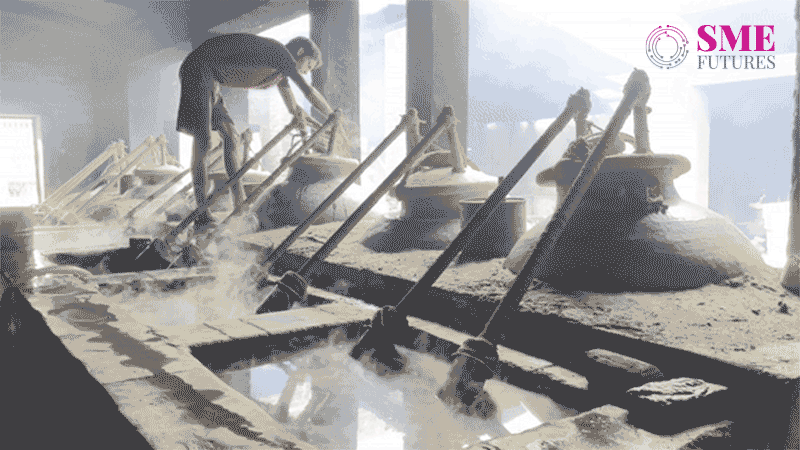It’s just another ordinary day! Ram Singh, who is in his 50s, cycles to work. He meets his colleagues at ten o’clock in the morning as he unlocks the doors to a century-old workshop. Everyone hastily changes into their work clothes and start prepping the copper deghs. In about fifteen minutes, the raw material—fragrant light pink petals (Damask roses) are carefully weighed. At the other end of the workshop, water is filled into the deghs, the fire is lit, and the deghs are mud sealed with rose petals—where at the end of the day, it will become Gulaabjal. Every day, this is the life of the skilled workers of the attar industry in the small city of Kannauj, known as the perfume capital of India.
It’s an ancient art
Historically known as Kanyakubj for centuries, Kannauj has always been renowned for its traditional style of perfume making and for concocting exotic and unique attars. Once there, the mix of modern and classic architecture that abounds in this city, will give you a sense of its early days of grandeur. The hustle and bustle of the narrow lanes of Bara Bazaar and the old shops laden with colourful glass bottles reflect the alchemical legacy of this place.

When it comes to the history of this alchemy though, everyone has different versions. Historians say that it dates back to the pre-Vedic or Vedic period, which is linked to yagnas or fire sacrifices. “Evidence has been found in various Indian pieces of literature such as in the Brihat Samhita by Varahamihira—where lots of formulas are written,” says a research paper. Another paper says that it reached its glory during the 7th century AD. “It is during this period that Kannauj started to play an important role in Indian perfumery, perhaps deriving the knowhow from the ancient Indian texts like Charak Samhita and Gangadhara’s Gandhasara,” it says.
Also Read: Moonlighting: How unethical or justified is it
In the medieval period, Kannauj provided the Mughal emperors with scented oils. “The range of such materials and essential oils was further enriched during the Mughal era when new plants were brought by the Mughals from Central Asia to this country. This led to the discovery and development of a process for the preparation of attar from roses by Noorjahan, the Mughal queen. Thus, Kannauj became a perfume city just like the city of Grasse in France,” the paper further elucidates.
Business of aroma in modern era
Walking down the streets of Kannauj, the notes of different scents will linger in your senses for a long time. It’s like walking in a garden full of flowers, says Dinesh Kumar, who has come to Kannauj on a business trip.
Kannauj perfumes were granted geographical indication status in 2014, enhancing their global market presence. In figures, there are no reliable statistics about the revenue or even about the output that this town generates. However, it’s clear that export contributes more than retail does.
The market size figures are also not precise, as everyone has their own estimate of it. However, according to a media report, Kannauj’s perfume business is now worth over Rs 1,200 crores, and nearly 80 per cent of its population of over 10 lakh people is directly or indirectly involved in the industry.
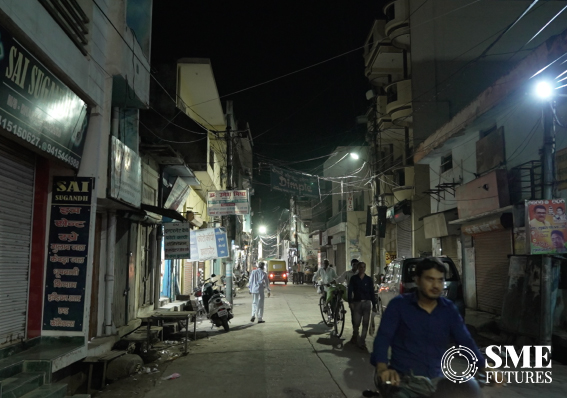
“India is a big consumer of attars, scented oils, and perfumes. Having said that, the big share is exported to the Middle East, where perfumes and attars are a big part of their daily lives and rituals. India also exports to Europe and The United States, where attars are used as a raw material rather than for simple application,” says Pranjal Kapoor, the fifth-generation entrepreneur and partner at ML Ramnarain Perfumers, one of the oldest perfume makers in the country that continues to adhere to the traditional tenets and techniques of perfume making.
According to him, if we ignore the pandemic period, the Kannauj perfume industry has been doing exceptionally well. “Fortunately, we were spared the worst of the pandemic. Compared to the rest of the ecosystem in Kannauj, our business was not too affected,” he tells us.
Also Read: TATA identifies over 125 Indian MSMEs for domestic manufacturing of transport aircraft
But others were not so fortunate. Especially the small attar businesses in the area who have had to deal with a lot of challenges and continue to do so even today.
Pandemic put a damper on perfume business
“The market needs much more hand-holding than you think,” says Mohammed Akbar, owner of Assam Trading & Fragrances, when he was asked about how the market is performing right now.
Looking dissatisfied with the current scenario, he tells us that the small perfume business owners are struggling because of the severe losses that they have incurred in the last two years. “The market is shrinking. People are struggling to do business in this tight situation and the manufacturing is getting too expensive to handle,” he laments. According to him, the government has not been all that receptive to the problems of these small business owners either.
Another retailer, Imroz Ahmed of Wave Perfumers, welcomes us as we approach him. “I have seen the better days of this market. But this present situation is not something that we had ever expected. In reality, the pandemic has stalled our growth and our sales are significantly down. Earlier, the market used to teem with delegates from different regions, if not the entire world. The market feels a little deserted nowadays. Buyers who used to visit once a month now come once every three months,” he says as sweat drips from his forehead.
Also Read: RBI’s monetary policy committee to meet on Nov 3 over inflation
He has been dependent on the monthly sales as well as the exports of attar to the Middle East region, both of which have reduced significantly.
The general belief amongst the stakeholders of this industry is that only the larger players have survived and that the market has become quite centralised.
Temperature, tax and trade, three ills plaguing Kannauj right now
“Is saal mausam ne saath nhi diya,” a woman farmer reveals as she plucks small roses from large bushes. She was too shy to say her name, but after a bit of cajoling, she managed to say a few words.
In practice, the favourable period for cultivation begins in March. But this year, India witnessed an extreme summer, which affected quite a few sectors, including agriculture. Needless to say, rose, mehndi aka henna and jasmine cultivation have all gone awry, according to the farmers of Kannauj.
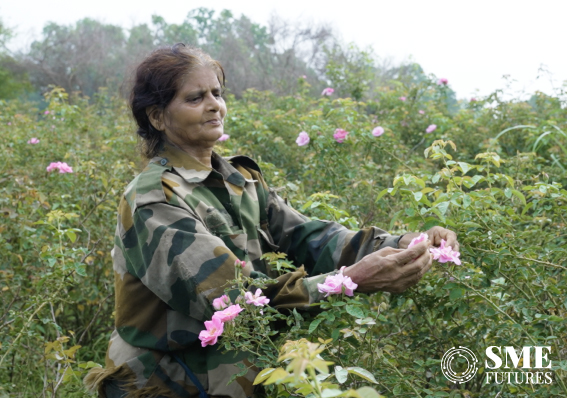
Gopal, another farmer tells us that the heat destroyed the flower crop. “Though irrigation saved my plants, the flowers did not bloom to the expected sizes. The rose flower grows after getting moisture, but this time the flowers were small. Only 30 per cent of the crop remained viable,” he tells us.
For years, the market has been working like a precisely drawn flowchart. Each year, the rates are already fixed for the raw materials—roses, jasmine, and mehndi. This time, the market was different. The prices escalated due to the shortage; even the black market had its day in the sun—25 per cent of the transactions were done in black.
Also Read: India’s textile sector aims $100-billion exports in 5-6 years: Goyal
The heat did not spare even the mehndi flowers. The crop was 30-40 per cent lower than last year. It is being estimated that due to the uneven weather, the prices of rose and jasmine might further escalate in October. Which will be a big problem for the small manufacturers.
On the other hand, GST has also been a pain for the perfume makers. “There is also a problem with the increased taxes which has affected our business. Earlier, there was no tax on rose water, but it is there now. It’s 18 per cent to be precise,” says Ahmed of Wave Perfumer.
You know, there are various kinds of ‘itr’ or ‘attar’ made from roses. Now imagine an itr that was earlier priced at Rs 400, being sold for Rs 500 today. “If rose water had become tax-free, then the overall costs would have come down along with the selling price. Customers would have bought more. But that’s not happening. Demand has drastically fallen, and the buyers have decreased,” he laments.
That’s not all, due to an unprecedented hike in fuel prices, the cost of the other raw materials is skyrocketing. For instance, the prices of solvents such as Dioctyl Phthalate (DOP), Diethyl Phthalate (DEP) or Heavy Liquid Paraffin (HLP) have more than doubled now.
Also, sandalwood oil, which is one of the key ingredients in attar making is now exorbitantly costly. One of the industry insiders on condition of anonymity tells us that in the Veerapan era, sandalwood was easily available. “However, at present, sandalwood cultivation has decreased significantly. Mostly due to poaching or smuggling. Also, due to the stringent rules and regulations, sandalwood prices have gone up exponentially. Which makes it out of reach for small manufacturers like us,” he says as he pours the precious liquid into a beautiful glass vial.
Finding substitutes for sandalwood, according to business owners like him, has had a significant impact on the industry over the years.
We aren’t good marketers
Talking about the various issues that are hindering their growth, the manufacturers tell us that one of the main challenges that they are facing is the lack of opportunities. Despite attar being a ‘One District, One Product’ item and being greatly in demand in the international markets, its small manufacturers haven’t grown with time. According to the industry data, there are more than 300 units that are involved in traditional attar making.
“The perfume industry in Kannauj is viewed more as a raw material supplier,” says Kapoor.
Also Read: Govt extends deadline for ethanol production scheme
He tells us that despite sitting on a gold mine, the manufacturers are lagging in marketing their products. “This is one of the challenges that this sector is witnessing,” he says.
“We don’t have perfume brands that have gone international as an end product compared to countries like Italy, France or Switzerland. We are just raw material suppliers. And we have not been really able to focus ourselves on becoming an end product,” Kapoor comments. According to him, this is one of the reasons behind India not having an international label in terms of perfumes or fragrances like Gucci, Chanel, D&C and Estée Lauder.
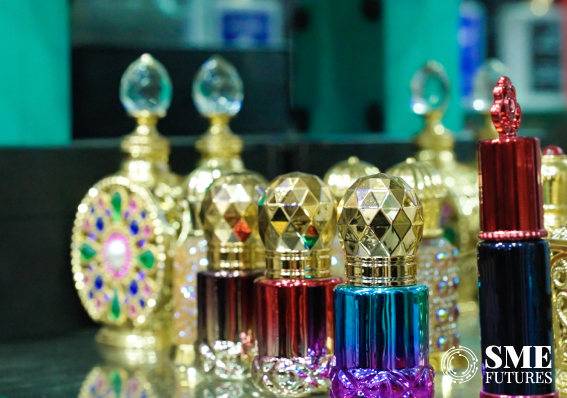
“We are not good marketers of our products. We don’t present our products in the manner that the French present their perfumes. We are sitting on a gold mine, and we have a lot of natural resources; but we don’t market ourselves well enough to our western clients,” he asserts.
Stakeholders like him reason that the attar industry is not very large, and everybody cannot do everything. There are a few big manufacturers, and the others come under the MSME category. So, it’s only natural that these units do not have a marketing or even an R&D department for getting exposure or for even developing new products, as the other international brands do.
At the same time, even if e-commerce and D2C are there, the emphasis on raw materials makes the stakeholders reluctant to go online as there is little to no screening there of what is original and what is fake. “Due to various reasons, manufacturers have started using substitutes in their compositions. They are not original. And they are cheap compared to our attars, but we have to compete with them,” says one of the retailers in Bara Bazaar.
Cooking up perfumes—not for Gen Z
Regardless of the antiquity of perfumes, what distinguishes Kannauj is that it still uses centuries-old methods to concoct attar, primarily through hydro-distillation. “The real magic actually happens in these traditional distilleries. These are the main people who are running the vessels in the distillery,” says Kapoor pointing towards his employees who are diligently working on the century old work floor.
However, the manufacturing units are finding it hard to stay afloat due to the decreasing number of skilled workers trained in the art of perfumery.
Ram Singh, a master perfumer has lived all his life in a distillery, concocting attars and training others on how to do it, but his children will not continue this trade. “In this work, one must have heavy tolerance. Workers had to bear very hot temperatures, smoke, flames. Sometimes its injurious,” he tells us.
Also Read: India’s growth resilient despite exogenous threats: FM
“I don’t have a number to tell you about how many people I have trained. I have been doing this for 30+ years. But now my next generation do not want to be distillery workers, as there is little renumeration. And they have their own dreams,” Ram Singh adds.
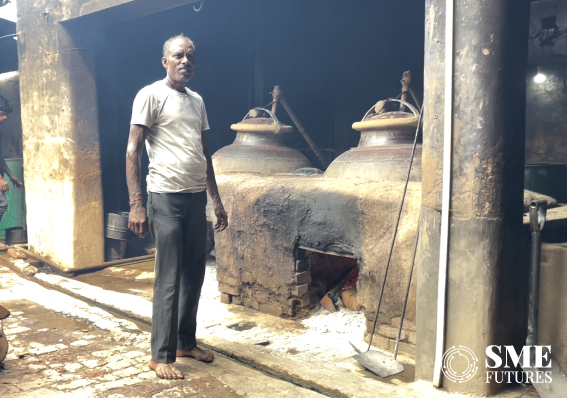
It’s a fact that the attar industry has been witnessing an acute decline in its units and also in the number of skilled workers associated with it. Next to COVID, the lack of money and the low remunerations in this sector have been the main reasons for this skill shortage. Also, Gen Z has little to no interest in this traditional art of concocting fragrances.
“Finding a skilled workforce—that’s another challenge. We have workers but their next generations do not want to take their place. Our town is small and now Gen Z see their future in the metros and the big cities, which can provide them with more opportunities and jobs with good prospects,” explains Kapoor.
Perfume Park: Where is it?
One of the biggest points of contention that the stakeholders of the Kannauj attar industry have with the powers that be is The International Perfume Museum and Park, which the past state government had proposed to set up at least six years ago. This project was supposed to put the domestic attar industry at the forefront of all the other clusters.
However, to the utter disappointment of the stakeholders, this Perfume Park project is yet to see the light of day.
“At least 60 to 70 per cent of Kannauj’s population, from the farmers to the attar makers to the retailers, rely on this occupation. In recent years, even the farming areas for rose, jasmine and henna have increased. One challenge that we are facing is that there is no dedicated area for the stakeholders,” says Prakhar Kapoor, Secretary at the Attar Industry Association.
In 2015, the then state CM, Akhilesh Yadav had led a delegation to Grasse, the perfume capital of France, to explore the opportunities for the attar sector there. A year later in 2016, this government announced the ambitious project to establish the park on 400 acres of land. But the project was stalled.
“Attar Park is only on papers,” says Mohammad Akbar. “We heard about it, that the government will establish a perfume park, but for years, there has been no work done,” he says sarcastically.
Also Read: MSMEs to avail of all non-tax benefits for three more years
The proposed park area has shrunk to 100 acres over the years. According to several media reports, the park is nowhere to be found, instead a half-finished wall stands there, with an unanswered question—where is the perfume park?
Will the gift diplomacy work?
Kannauj’s market is a labour-intensive and resource-intensive sector that has withstood the test of time and continues to face numerous challenges. The stakeholders have been vocal about their issues and feel that there’s no respite for them.
A few industry experts are claiming that the government has initiated a few measures to turn the tide in their favour. We recently witnessed an array of diplomatic gifting at the recently held G-7 summit—where prime minister Modi gifted eight ODOP products to various leaders—Kannauj itr bottles were amongst these items.
“France’s Grasse is the Mecca of perfumery. The head of the country, I mean the French President has been gifted a set of attars by the Indian PM. From my perspective, it’s an extremely strategic move. The government is taking measures in its own way with its strategic thought process, followed by some other initiatives,” says Kapoor. In his opinion, the move is strategic and may open up wide avenues for this industry.
Meanwhile, the unanimous feeling amongst the perfumers of Kannauj is that we are at par with Grasse, which is called the perfume capital of the world. In fact, the stakeholders say that we are way better and far older than them. Also, Kannauj’s attars have an advantage over perfumes—they do not contain alcohol. And the ancient art of distilling it is unique and irreplaceable. But despite the legacy that Kannauj is known for, it is not garnering the attention that it deserves.
Now with the government trying to put Kannauj on the map as a tourist destination with the development of the Perfume Park, we can only hope that things will get better for this ancient and storied land of unique fragrances.

